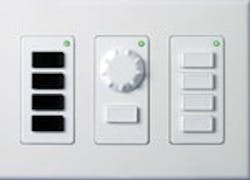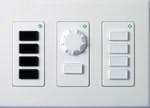DALI Explained
DALI: This four-letter acronym stands for Digital Addressable Lighting Interface, but what is it? How is it different from the lighting system you currently have? Why should you (or why shouldn’t you) pursue DALI in your own facilities? Who can use it?
What is DALI?
Put simply, DALI is a two-way communication system that brings digital technology to lighting. An international standard for communication, DALI defines the commands that LED drivers and ballasts need to recognize. The system allows individual LED drivers and ballasts to “talk” to the user, and allows the user to “talk” back via DALI controllers, computers equipped with appropriate software or building management systems.
On topic: Lighting Trends at Lightfair 2018
“DALI sends messages around, and just like computer networks, those messages are picked up by the ballasts via addresses,” explains Wayne Morrow, president, Westminster, CO-based Starfield Controls. “The ballast with that address picks it up and follows the instruction. A simple message would be, ‘All lights in Room 10 turn off.’ You send that message, and all the lights in Room 10 know who they are. They pick up that message and say, ‘It says here I’m supposed to turn off.’ And that’s what [happens].”
Stuart Berjansky, former dimming product manager, Rosemont, IL-based Advance Transformer Co., explains that DALI is similar to a 0-10V system due to features like low-voltage wiring and daylight harvesting capabilities. “But, I call [DALI] 0-10V plus, because it gives you even more,” he says.
Communication in a 0-10V system is unidirectional; the control system tells the LED driver or ballast what to do, and it adjusts according to the voltage on the control circuit. DALI, on the other hand, provides a two-way method of communication, giving the LED driver or ballast a chance to communicate as well.
Read also: LED vs. Fluorescent: Are Linear LEDs Ready to Replace Your T8s?
How long has DALI been around?
The history of DALI is interesting. The idea first came from a ballast company in Europe. Three other ballast companies joined with the first to form a proposal for the International Electrotechnical Commission (IEC) to create a standard on communication protocols used for ballasts. In the mid- to late 90s, the United States became involved as well.
“[The standard] is included in the IEC standard for fluorescent ballasts, and it’s one of the annexes in the standard,” says Pekka Hakkarainen, director of technology and business development for Coopersburg, PA-based Lutron Electronics and chair of the Lighting Controls Council at Rosslyn, VA-based National Electrical Manufacturers Association (NEMA). “It defines a method of communicating to the ballast that the industry has agreed on.”
DALI was accepted as an international standard in 2002; the first DALI LED drivers and ballasts were introduced into the U.S. in the late 90s.
How does DALI work?
Most of the hardware used in a DALI system is the same as what’s used in a more typical system. The big difference: With DALI, LED drivers and ballasts can be linked to a central computer, allowing each to be controlled independently. DALI systems are available for T5, T5HO, T8 and compact fluorescent lamps.
LED drivers and ballasts are connected using Class 1 (inside the conduit) or Class 2 (outside the conduit) wiring to make up a loop of no more than 64 LED drivers or ballasts. Each is given an address in the DALI system, and the loop is connected to a DALI control device. One individual network isn’t enough to cover an entire building; rather, several must be linked together to create a “network of networks,” Morrow describes.
Who’s using DALI?
Installing DALI technology installation can be retrofit, but installing during new construction is best. “Almost all buildings should be running DALI wires at this point because it’s so cheap," Morrow says. "That one’s almost a no-brainer.”
Trending: 5 Steps to Optimize Your Facility with Data Analytics
Mike Williams, former product marketing manager at Danvers, MA-based OSRAM SYLVANIA, agrees. “Where the building owner is going to get the biggest bang for his buck is definitely on new installations,” he says.
“When you put it in a retrofit, you don’t gain all the advantages DALI can provide,” explains Advance’s Berjansky. “With DALI, when you wire it up, you wire your lighting independent of your lighting control circuits. When you look at an existing building, those circuits already exist; you have one switch for those 10 fixtures and another switch for these 10 fixtures. You’re limited in taking advantage of that lack of requirement for control circuits.”
DALI isn’t used very often in U.S. applications. U.S. controls manufacturers never embraced DALI the way the rest of the world has.
Why should I use DALI?
1. You can easily reconfigure your lighting without having to tear into the ceiling, making the process of rearranging people, offices and furniture easier.
“You don’t have to re-route the control wiring to the fixtures,” explains Williams. “You can just reconfigure the DALI fixture to tell it, ‘Now you take commands for this new control scene (grouping) as opposed to the one that you used to listen to.’ Changes can be done via software instead of going in and doing hard-wire changes.”
2. Lighting can be tailored (either individually or across the entire facility) to accommodate peak demand, amount of visible daylight, energy rates, etc.
For example, in an office area, some lights can be adjusted as necessary without affecting the other lights in the room. Other systems provide this feature as well, but DALI allows the user to control each light separately.
3. Open protocol allows for many different companies to be involved.
“Interoperability is huge,” explains Morrow. “We can all co-exist on a DALI network. We worked very hard at that interoperability.”
4. Installation of the control wiring can be simple with DALI’s five-wire system.
“To gain the level of control people need in conference rooms and office floors, you normally have to pull a lot of wiring to make sure all the devices are connected. You don’t need to make those same types of interconnections with DALI. It’s a simple two-wire control connection that goes to each fixture to form the control network,” says Williams.
And, as Morrow points out, “You can have fairly low-skilled labor pulling in your wire because they don’t need to know about zoning, and they don’t need to keep track of control wires like you would with a relay system. The relay system might have 30 or 40 wires in a conduit, and each one has to be labeled, pulled to a specific spot, and made up to a specific location and panel. DALI only has two wires, and they go everywhere.”
5. As with other systems, DALI allows pre-set lighting scenarios to be created and achieved with the touch of a button or click of a mouse.
For example, in a ballroom that serves many different purposes throughout the day, one button may be pre-programmed to set the lights appropriately for a morning meeting. Another button may be pre-programmed to set the scene for an evening concert.
6. Due to DALI’s two-way communication, LED drivers and ballasts can be queried individually to check energy usage.
If the lights in your facility are assigned to tenants, billing can be done per tenant. “It allows you to meet energy codes both now and in the future," Morrow explains. "There’s a strong expectation that utility companies will provide more and more incentives for these types of features. You can lower your peak demand in response to a utility directive, which will give you a lower utility rate.”
7. LED drivers and ballasts can also be queried for lamp and ballast failure.
“In the Pentagon, they tell us they have 250 lamp failures a day in a building with 6 million square feet. They have a person full-time who just replaces lamps, but they don’t know where those failures are,” says Morrow. Berjansky raises the same advantage: “Wouldn’t it be neat if you never got a phone call from an angry tenant saying, ‘My lights are out’ or ‘My ballast went out’? It allows you to be proactive as a building manager.”
Williams agrees. “The power of this system, being able to have the communication come back to you from your lighting system to see how it’s behaving, will resonate with a lot of people; especially if you have a huge number of buildings to maintain. This saves maintenance from having to walk through your buildings periodically.”
Why should I think twice?
1. The initial set-up of the system involves creating a catalog or database to associate LED driver or ballast addresses with physical locations and with the control device that operates them.
Not only does that database need to be created, it needs to be maintained. “If it’s not, the system will quickly become unusable,” says Hakkarainen. “If the layout of the space changes and the database isn’t updated, the control devices will likely control fixtures that they’re not expected to control.” Many experts recommend that IT staff should be involved in the database creation and maintenance.
2. It’s not always easy to figure out.
“Installation is nearly identical to conventional low-voltage controllable lighting systems. However, there’s a learning curve involved in getting to know how to install it and perform the commissioning,” explains Williams. In other words, it will take time to gain the appropriate knowledge needed to use and maintain the system efficiently.
3. DALI isn’t ideal for every situation.
If the application is simple and doesn’t require dimming, occupancy control or individual user control, DALI isn’t the answer. “A light switch is a fabulous way to turn lights on and off, as long as nothing’s ever going to change,” explains Morrow.
4. Controls can be expensive.
“DALI is certainly more pricey than a conventional wall switch,” says Morrow. Initial cost can sometimes scare building owners away, but Berjansky emphasizes that cost can be made up in labor savings. “If you take a traditional 0-10V system and a DALI system, the installed cost for both will be about the same. Your ballast is going to cost you more, but you’ll save in labor because of the lack of lighting circuit requirements. You have less homeruns going back to your electric panels, you have less electric panels,” he explains.
5. It’s a big change from a typical “on/off sweep” system.
“I don’t think someone would go from doing a standard switching system to the DALI system. That’s a big jump. If they were already going to be doing a dimming system, DALI may be a logical step,” says Berjansky.
How do I make a decision?
Now that you know the basics, the decision may be a little more straightforward. Do your buildings contain several multi-function rooms that require different lighting options depending on time of day, the event being hosted, etc.?
Are tenants asking for more personalized control over their workspaces? Is the layout of the space uncertain at the time lighting decisions are being made?
“There have been statements made by some people in the lighting industry that make DALI seem like the panacea that we have all been waiting for. DALI is a technology tool much like any other tool: It offers some capabilities that are not available without the tool, but requires that the user be properly trained,” emphasizes Hakkarainen.
Related: The Amenities Tenants Really Want
“It definitely has its merits,” explains Berjansky. “But, if you try to force-feed it into somewhere where it doesn’t belong, DALI’s just not going to work.”
Leah B. Garris was an editorial coordinator at Buildings Media. This article was originally written Aug. 5, 2003 and updated July 5, 2018.
Two hand-picked articles to read next:

